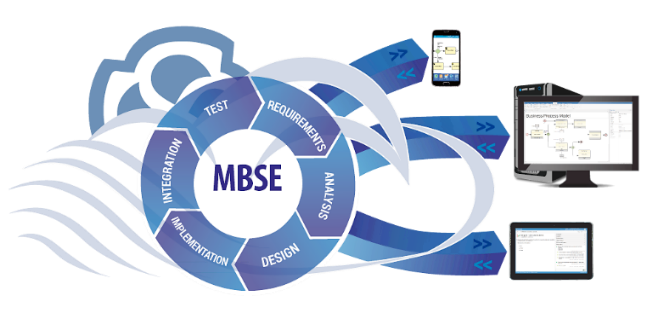
In exact terms, Model-Based Systems Engineering is a formalized application of modeling to support system requirements, design, analysis, verification and validation activities beginning in the conceptual design phase and continuing throughout development and later life cycle phases.
In our words and why it has helped us support our clients for the last 10 years; it is a way to capture and relate design data like Architecture Diagrams, Component Properties, Critical Process Flows, and Requirements into a model in order to improve Engineering Design analysis, Improve Interoperability, and reduce impact assessment timelines. The model is configuration controlled so that all users know where to find the necessary data and know that its’ the current version. It is integrated into a customer environment so that it can be used to support multiple types of analysis during multiple phases of engineering design.
This may still sound like a lot of words to describe a process so let’s break it down even more…
What is the value of this approach?
Previously the above data points were captured separately in flat-file format artifacts and not related, which made it time consuming and difficult to identify the current engineering baseline, as well as perform modernization analysis, security design tradeoffs, or simulations and what-if scenarios. Capturing and relating those design artifacts into an MBSE model allows the user to quickly identify their current baseline and provides the foundation and ability to improve analysis and reduce the time to do it.
Why are more and more companies switching to MBSE?
Companies are experiencing the challenges that they face working with their current document-based methods of doing engineering design and analysis, and at the same time recognize the benefits that MBSE provides.
How does MBSE support IT security?
While the advances in technology are increasing globally, and improving capabilities, those same advances also increase the complexity in designing, implementing, maintaining, and protecting those IT assets. MBSE provides a strong foundation to manage and protect a company’s critical assets.
Can you give me an example of when to use MBSE?
It is valuable to use it when performing System Requirements Analysis, and Architecture and Operations/Processes Design, because the model allows you to quickly see holistic impacts – not just one area like the architecture, but also the functionality that is impacted and the associated requirements. By modeling the architecture change, you can simulate its performance in order to identify performance impacts early in the design.
Where do I go to learn more about whether it is valuable to my company?
There are books that provide background and fundamentals on MBSE, and courses that can teach folks how to implement it. G2 Ops has been designing and managing systems using MBSE and helping companies migrate to an MBSE infrastructure for almost 10 years, so we’d love to discuss how we could improve your current challenges and help sustain and protect your company into the future.
